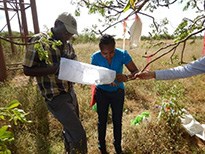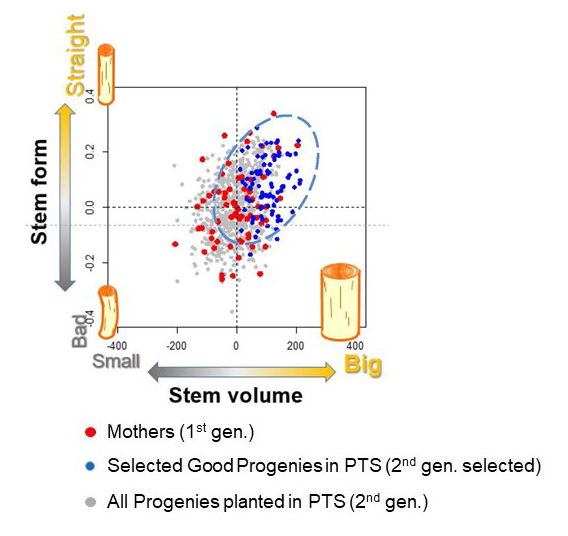Home > International Partnerships > Collaborative Research > Capacity Development Project for Sustainable Forest Management in Kenya (Tree Breeding Component)
Update:October 27, 2022
Main content starts here.
Capacity Development Project for Sustainable Forest Management in Kenya (Tree Breeding Component)

1.Partners
Kenya Forestry Research Institute (KEFRI), Kenya
Kyushu University, Japan
2.Research Period
September 2017-November 2021 JICA Technical Cooperation Project
3.Lead Researcher
UBUKATA, Masatoshi (Genetic Resources Department, Forest Tree Breeding Center) (-FY 2020)
YAMADA, Hiroo (Genetic Resources Department, Forest Tree Breeding Center) (FY2021-)
4.Background
This 4-year project follows on the previous JICA tree breeding project entitled “Project on Development of Drought-Tolerant Trees for Adaptation to Climate Change in Drylands of Kenya” (2012–2017) and is one component of the “Capacity Development Project for Sustainable Forest Management in Kenya.” In this project, a new research activity was implemented that involved the artificial crossing of Melia volkensii to produce a second generation and the analysis of progeny test site (PTS) data for M.volkensii and Acacia tortilis.
5.Research Goal
The final goal of this work was to progress our breeding research ability toward the next generation by developing breeding technology of drought tolerant tree species and transferring this technology to the researchers in KEFRI.
6.Research Strategy
Undertake the following research activities to complete the cycle of Melia / Acacia tree breeding and produce the second generation:
1) Establish production on population of improved M.volkensii as early as possible by improving existing M.volkensii seed orchard based on Progeny Test.
2) Improve A.tortilis seeding seed stand to develop the second generation.
3) Investigate mating system of entomophilous M.volkensii and develop artificial crossing techniques as an alternative matting measures toward the second generation.
7.Scientific Achievement
The M.volkensii artificial crossing test showed that some parts of the inflorescences that had been artificially pollinated had fruited (Photo). The test also revealed that artificial crossing requires so much labour that it is not practical as major method of pollination in the orchards. Study of mating system which shows how crossbreed/mating occurs actually was under way with FTBC’s technical guidance of analysis.

Photo Melia volkensii artificial crossing test at Tiva seed orchard
Plus tree traits tables of 1st generation seed orchards were compiled based on the analysis of growth and other traits data estimated in the PTSs.

Fig. Selection result
Selected 2nd generation Melia which have superior growth and stem straightness. (Matsushita, M., Ubukata, M., Ichikawa, H., Jason Kariuki (2021) Selection of 2nd generation Melia in Africa. Report of research results in the 4th Midterm Plan, Forestry and Forest Products Research Institution, 90-91.)
The quick and generally smooth growth of M.volkensii progeny tests allowed early selection of selected 2nd generation. Superior growth, stem straightness and healthiness were measured in the PTSs and seed production was evaluated in the clonal seed orchards (Fig.). The Kenya-Japan experts discussed the way M.volkensii clonal seed orchard and A.tortilis seed stand should be managed and made manuals of management of seed orchard and seed stand.
The experts from FTBC continuously promoted the propagation techniques and nursery management skills to ensure the quality of the planting materials as these activities are crucial in the establishment of clonal seed orchard, progeny test field, a seed stand and demonstration forest.
8.Applications
The seed production in the two seed orchards established by project were increasing year by year and thus contributed to increasing forest area through the distribution of these seeds of improved Melia to community. It is expected that the developed techniques such as seed orchard establishment will be extended to private organization which will collaborate with Project to promote planting Melia. These outputs will be a base on developing the next generation in the new project starting in February 2022.
9.Publications
Hanaoka, So (2017) Introduction of Tree Breeding for Melia volkensii in Kenya. Workshop on technical development held by Hokkaido National Forest Regional Office in 2017.
Kyalo, E. (2018) Melia volkensii Growing in the Drylands of Kenya. Promotion Seminar on Melia Woodlot in Kenya. Capacity Development Project for Sustainable Forest Management (CADEP-SFM).
Matsushita, Michinari (2018) Tree Breeding -Current results of Breeding of Melia volkensii-. Interaction Workshop for Capacity Development Project for Sustainable Forest Management, #04.
Muturi, G. M., Kariuki, J. G., Ndufa, J. K., Musyoki, J., Omondi,S. (2018) CADEP: Component 4 Tree Breeding. Interaction Workshop for Capacity Development Project for Sustainable Forest Management.
Omondi Stephen F., Machua Joseph, Muturi Gabriel M., Gicheru John M., Hanaoka, So (2019) Evidence of high genetic diversity and significant population structuring in Vachellia tortilis (Forsk.) Galasso & Banfi population in Kenya. Annals of Forest Science, 76, 1-14.
Miyashita, Hisaya (2019) Improvement of Seed Orchard according to the Progeny Test through Nondestructive Wood Property Testing on Tree Breeding Project in Kenya. IUFRO research meeting, 21st International Nondestructive Testing and Evaluation of Wood Symposium.
Kariuki, J. G.(2019) Activities and Plans for Component 4(Tree Breeding). Interaction Workshop for Capacity Development Project for Sustainable Forest Management.
Ichikawa, Hidetaka (2020)Research Report, Tree Breeding project in Kenya. Ringyo Ibaraki No.753.
Miyashita, Hisaya (2020) Forest Genetics and Tree Breeding. International conference presentation, 21st International Nondestructive Testing and Evaluation of Wood Symposium.
Miyashita, Hisaya (2020) Forest Genetics and Tree Breeding. International conference presentation, IUFRO Seed orchard Conference.
Hanaoka, So (2021) Suggestion for genetic resources management of Melia volkensii in Kenya. IFURO Word Day Poster (On-line).
Copyright © Forest Research and Management Organization. All rights reserved.
